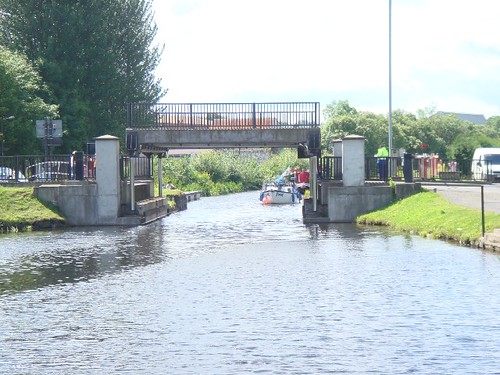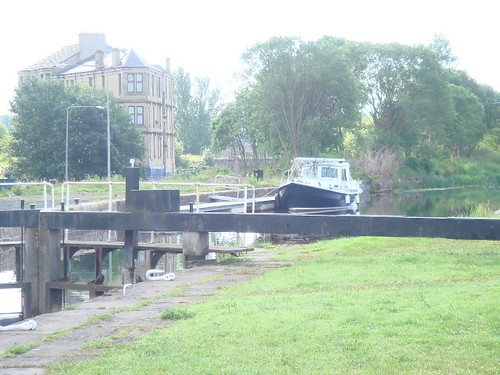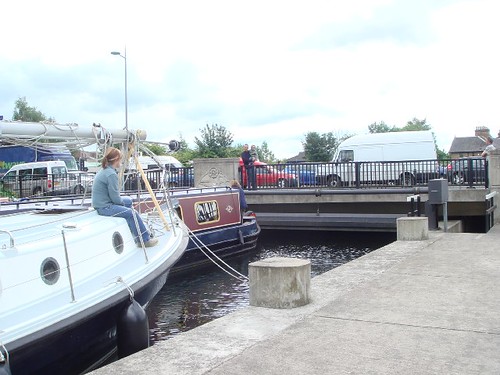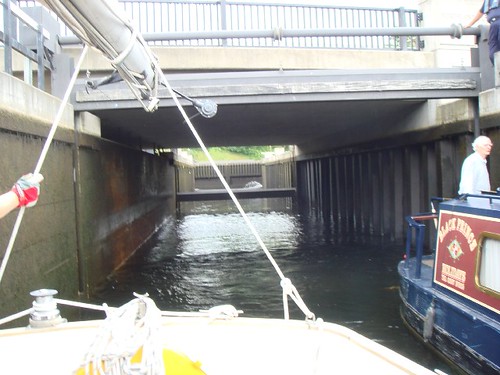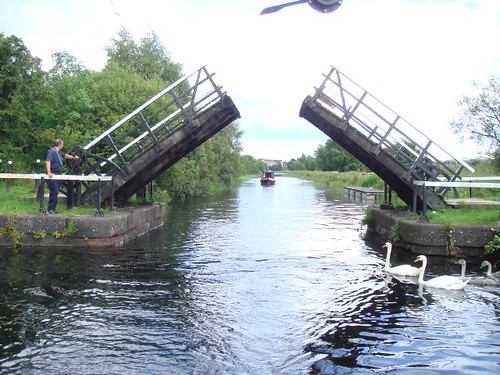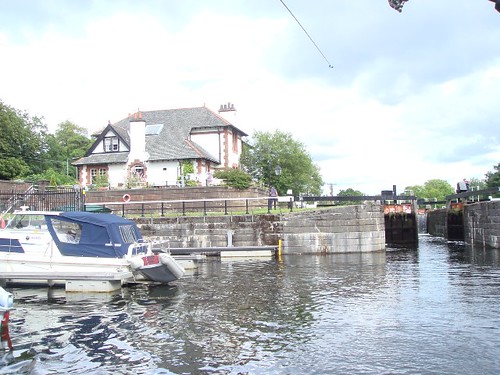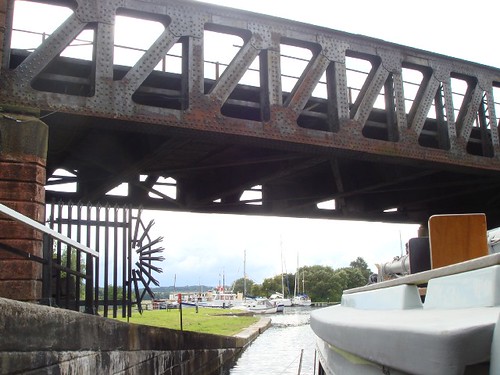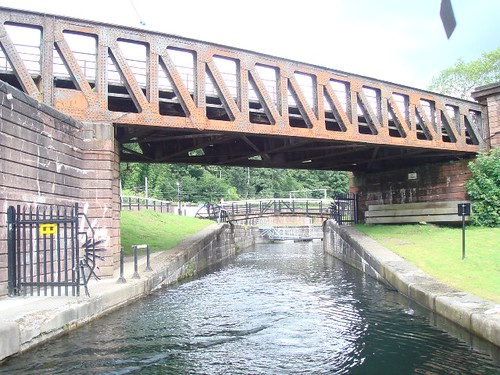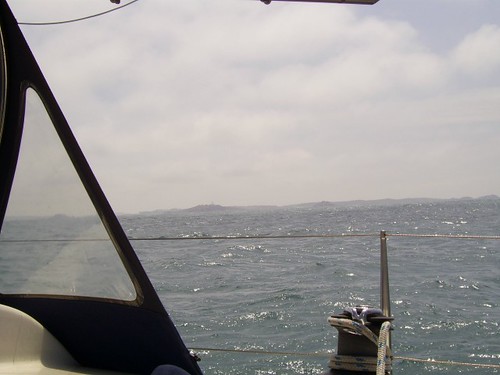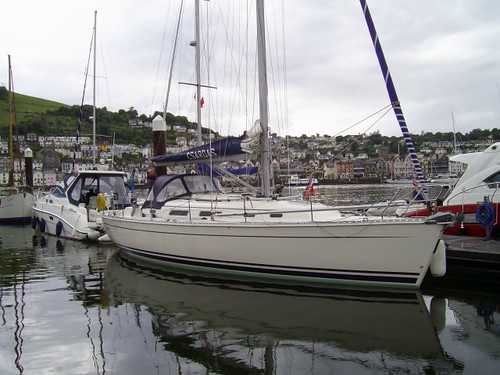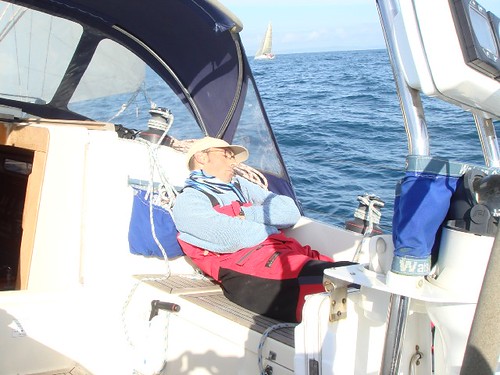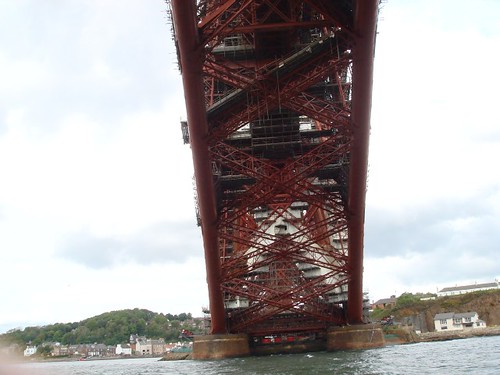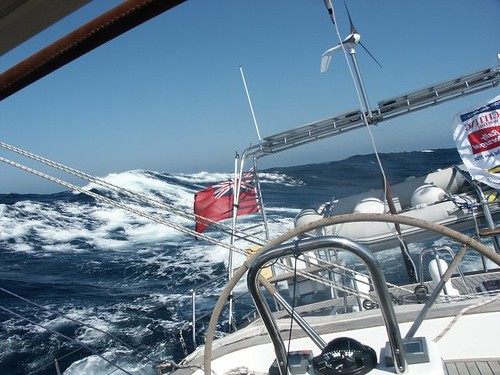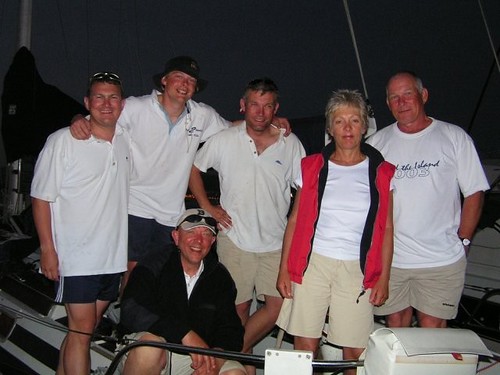7th July 2007
Having clarified with the staff of British Waterways that the maximum air draft to facilitate a transit through the canal was 3 metres we prepared Sun Dog and carefully measured the air draft as being slightly under the maximum at around 2.9 metres.
We set out from Port Edgar to arrive off the Carron River entrance around 18.15 as previously arranged with the guys from British Waterways.
On board was myself, my partner Sara and her good friend Eilidh who had not been on a yacht before and also had never been through canal locks either. Eilidh was keen to take the helm so once clear of Port Edgar she took the helm in a F3/4 wind against tide situation with the associated short choppy waves.
I’m delighted to state that she was as happy as a sand bunny riding through the waves. As for me; I was pleased that I had taken the time to lash the mast and boom securely to Sun Dog as this would not have been the time to try and re-adjust !!
We had pre-booked our slot to get into the first lock (currently numbered Lock 2) but first we had to get up the Carron River with enough water underneath us whilst having sufficient air draft to get under the Kerse Road Bridge. Given the fact that the river level (impact on height) can fluctuate, we had arranged to give the lads at the Lock a call when we were approaching the river as they agreed to come out and allow us to follow them up the river to the first lock. This was the start of what can only be described as first class service from all the staff of British Waterways (BW) who were involved in our transit of the canal.
They asked us to follow them up the river (keep in our wake) while they were taking depth measurements with a stick all the way up the river.
To be honest I think this would be advisable for anyone transitting the canal with similar air draft, because at times we were pretty close to the banks of the river – local knowledge is a wonderful thing! I’m pleased to say that we slid under the Kerse Road bridge easily enough and entered the first lock and into the Forth & Clyde Canal proper to berth for the evening, mightily relieved and looking forward to the rest of the trip.
8th July 2007
The next morning we had been asked to be ready for around 08.00 to ensure we completed all the paperwork and provide a copy of insurance certificate ( a “must have” document) and were informed that we would be locking through with a 60ft barge that would eventually be cutting off to join the Union Canal at the Falkirk Wheel (as they were heading for the centre of Edinburgh) . Going through the locks with the barge crewed by Charles & Hamish was a lot of fun – nice guys.
I have to say that the BW staff were exemplary in taking lines and working all the lock gates etc. Also Sara had given Eilidh some instruction on handling the ropes while going through the locks and she stuck to her task well, so well in fact it never once looked like this was her first experience of rope handling – well done Eilidh.
Our plan was to get through to the Stables at Glasgow Road Bridge and spend the night tied alongside, all through the locks Sara and Eilidh worked as a great team and made the whole process really easy and straightforward – not once did they miss a throw or end up with a rope in the water – really neat teamwork.
We said goodbye to Charles & Hamish at the Falkirk Wheel and wished them well on their return journey. We waited and waited for an operator to come down and open the bridge, so the girls had gone up to the Falkirk Wheel offices to find said operator. While they were away the person arrived Sod’s Law but it had to happen. I just cast off the lines and took Sun Dog through the bridge and picked the girls up on the other side amid much laughing and banter – so good for the soul.
We were to pick up another boat at the road bridge further down river and accompany them to the Stables.
There were some really lovely parts of the canal, and given the fact the sun was shining, really enhanced the experience. I really never thought it would be so pretty.
When we arrived at the hydraulic road bridge we had to wait while two other boats came through first, this was to be the first of a number of different solutions to the road crossings now in place since the canal was closed and subsequently re-opened. This bridge being hydraulic with some others being basic and others can only be described as somewhat ingenious – like the Falkirk Wheel linking the Forth & Clyde canal with the Union canal.
We duly arrived at the Stables and had a lovely quiet night alonside the pontoon. Chap next to us was not so fortunate as he had picked up a lump of plastic sheeting around his prop. However as luck would have it, he has a dry suit onboard and nipped over the stern to cut this away and disposed of it safely so that no other boat would have trouble with this particular piece of plastic.
9th July 2007
We set off from the Stables (Glasgow Road Bridge) at 07.00, as we had a reasonable run to get to the next set of locks at Maryhill in Glasgow and start our descent towards Bowling. En route to Maryhill we reached Stockingfield Junction ( a “T” Junction) where to go left ,would take one towards Port Dundas whereas we branched right for Maryhill and arrived at the top of the locks around 08.30.
Once again the BW staff were already there preparing the locks, and lo and behold another 60ft barge was joining us for the descent. They were heading for the penultimate lock gate before Bowling, therefore we would be in company all day. When we were going “up the locks” with Charles and Hamish and their 60 ft barge, they always went in first and were properly tied alonside before we entered. This time as we were going “down the locks” we had to enter the lock first and then watch a mass of steel heading towards our fibreglass boat. All I can say is 10 out of 10 for the chap at the helm of this barge and he was inch perfect in every lock – a mighty relief to me I can assure you.
After going down the initial batch of locks at Maryhill we tied up to a rest area where there were BW shower blocks and toilets – everyone took full use of the facilities and also took time to enjoy a cuppa and feed the swans.
After this we had only another lock to negotiate before arriving at the worlds only sail through Chippie – right in the centre of Clydebank. As we were approaching we could see that McMonagles restuarant was shaped like a boat. We had been told by the BW staff earlier that we could tie alongside the pontoons and walk back to the restuarant, or tie up at the “take away” window and get our Fish N’ Chips prior to going onto the pontoons. Well what would you do ? – Correct we did the same and pulled up the take away hatch……………really neat and a “must do” if transitting the Canal for the first time – a real novelty.
We had to stay tied alongside the pontoons while the walkway to the shopping centre was closed to pedestrians and the bridge raised enough for us to get under – a fairly substantial number of people stood around watching all this happen – again I think pretty neat and different thing to happen whilst out shopping!
With everyone suitably rested we once again set off heading for what was for me, going to be one of the highlights of the trip – going through the Dalmuir Drop Lock – which is one on the ingenious solutions on the canal. Boats arrive in the canal at the same height as the road and then they drop the water level down so that boats are below the level of the road – boats then motor underneath and them reverse the process once across on the other side……..really neat solution.
Exiting the Dalmuir Drop Lock we were asked to take our time getting down to the next bridge, which was one of the Bascule Bridges, and a neat fit for Sun Dog given the height and width of the wheelhouse – however we had been under others previously so no drama.
Onwards from here we had another type of crossing ahead, this time stopping the vehicle traffic as it was a swing bridge – but prior to reaching this we had a our first glimpse of the Erskine bridge which spans the Clyde and proved we were nearing the end of the transit.
Once through the swing bridge we had the penultimate lock before entering Bowling. The barges are not allowed to go any further once through this lock. If you look closely you can see the swing bridge only a few hundred yards astern.
Within another few hundred yards we were at the final lock into Bowling and as the barge was not allowed through this lock it felt quite spacious 🙂
Once through this lock we had only to get under the footbridge and old rail bridge, neither of which needs to be opened – and we were into Bowling Basin where we would get the mast back up and all the rigging adjusted. Incidentally this re-stepping of the mast is included within the transit fee – which makes it even better value.
10th July 2007
Decided on a rest day after getting the mast up the previous evening, but with all the wee jobs that needed doing- it wasn’t too much of a rest day! However we did get the chance to see a small fishing boat coming in through the sea lock, and we went for a walk to look at the wrecks that are in the outer harbour. These are no real navigational issue for entering or leaving the canal, and I guess in the fullness of time they will be removed and this area will be developed.
With the stick back up.
11th July 2007
All jobs done, topped up with water and fuel – the first refuelling since Marcus & I topped her up in Sunderland.
Total fuel 114 ltrs which equated to under 3 ltrs per hour since Sunderland – I reckon in the 16 hours the engine had been running in the canal (albeit barely above tickover) fuel consumption must have been around 1-1.5 ltrs per hour, as the overall fuel consumption when bringing her up from Ipswich was around 5 ltrs per hour at around 1600 revs. It will be interesting to see the consumption figures over the balance of the holiday.
Entered the sea lock at 11.00 in company with another yacht – once again BW staff were on hand to assist and hat’s off to Alex and all the guys from BW who made this transit so enjoyable and trouble free.
When the lock gates opened the skipper of the other yacht opened his trottle as if the Devil himself was trying jump onboard and the poor guy at the stern almost lost the lifebuoy and possibly could have got himself caught up whilst trying to get the line off……………….not good……………but thankfully no one injured and no damage done…that is good. But the Lord himself only knows why this skipper wanted to exit at warp factor 5 !!
Anyhow, out we went exiting the lock and into the harbour then into the River Clyde for the balance of our holiday. A wonderful few days with good weather, excellent company, and exemplary service from British Waterways staff.
Any fellow Rogger owners who are considering this transit through the Forth & Clyde canal can do this happy in the knowledge that at least one (perhaps a lot more) has/have already done so – it could save a fair amount of time if travelling to the West of Scotland /Ireland from Holland etc – an alternative to having to go up to the Caledonian Canal and transit from Inverness to Fort William. Currently the charges are £6.00 per metre for a transit and less than half that price for a return journey, and bear in mind this also includes the re-stepping/dropping of the mast in Bowling. We ourselves had dropped our mast in Port Edgar before setting off for the canal, but my undertanding is there are facilities for dropping/re-stepping the mast around Grangemouth Yacht Club – but if you have any doubts, simply call either Carron or Bowling Sea Locks as the guys are very helpful and a credit to British Waterways.
One final point to end this part of the blog – and as a general observation for anyone planning to transit the canal. My engine overheat alarm went off once when going through the canal, and when I checked the raw water filter basket it had a fair amount of weed restricting the flow of cooling water to the engine. An easy fix and no damage done, but in my honest opinion it would be advisable to check the raw water filter basket at each stop – only takes minutes! Just glad that I had an audible alarm as I might not have noticed the engine temperature climbing on the gauge.












